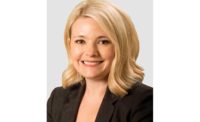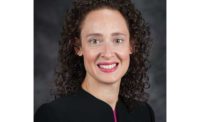Name: Shona O’Dea
Age: 30
Title: Building performance analyst, senior associate, DLR Group
Educational Experience: Master’s degree – the Sustainability, Technology and Innovation Concurrent (STIMS); M.S. technology, Purdue University; M.S. sustainability, technology, and innovation, Dublin Institute of Technology; and a bachelor’s degree, engineering, building services engineering, Dublin Institute of Technology.
Professional Credentials/Accreditations: LEED Accredited Professional; WELL Accredited Professional; CPHC, Certified Passive House Consultant; BEMP, Building Engineering Modeling Professional; and RESET Accredited Professional.
Organizational Affiliations: president, IBPSA Chicago chapter; regional vice chair, Young Engineers in ASHRAE; international outreach subcommittee, Young Engineers in ASHRAE; member, Illinois Green; past sustainability committee chair, and International Facility Management Association (IFMA). Presentations at Greenbuild, Neocon, ASHRAE, Simbuild, and the Passive and Low Energy Architecture (PLEA) conference. Awards: 2015 Simbuild Lowdown Showdown – Best Energy Use Results; 2016 Simbuild Lowdown Showdown - Most Innovative Workflow; 2017 Design Futures Council Emerging Leader Award.
When did you fall in love with engineering?
It all started when I was growing up in Dublin. My dad is an engineer and always had great answers to my questions about the world we live in. I had so many questions. I even recall my math teacher telling me I asked too many questions. These questions spurred my dad to tell me that I should take up physics, which I did. Physics sparked in me a desire to understand the science behind the numbers. It was then that I knew I was hooked. After high school, I decided to pursue engineering at Dublin Institute of Technology, as I had heard it was more application-focused than other universities on my wish list, with the intent to be a structural engineer. I changed my mind and decided to specialize in building services engineering (i.e. architectural engineering) after attending a ‘day in the life’ presentation of a building simulations expert who presented at the school. I was struck by the dynamic nature of thermodynamics and found it more exciting than statics of structures. Since then, building simulation has become my passion. It’s amazing to quantify the impact of a debatably ‘out there’ idea and make it something that a design team is willing to consider.
What has been the most rewarding aspect of working in the skilled trades?
Impacting something tangible and seeing the recommendations I have made to optimize a building become a reality — now that is an amazing feeling.
What challenges do women face in this profession? Why aren’t there more women in engineering?
Being successful, happy, and liked all at the same time in a gender incongruent role can be a challenge. Many behaviors expected for an engineer are traditionally deemed as ‘masculine’ and rewarded only in men; for example, assertiveness, confidence, and mathematical abilities. Research has shown that many find women taking on ‘masculine’ characteristics or men taking on ‘feminine’ characteristics to be unlikeable and causing an internal struggle of what traits to juggle. I’ve always had a fear that I would become too much of one or the other — super masculine or a shrinking violet — and I must admit that I make a concerted effort to feed and address both sides. Within ASHRAE, I’ve met many amazing women engineers, which has been a great way for me to encounter women who have succeeded at juggling these criteria. Role models and key women in leadership helping and mentoring younger men and women are imperative in changing and broadening our behavioral expectations. I’m passionate about promoting women helping women and also about making sure we are engaging all groups to move our industry forward. The truth is that we need individuals of all sorts to design the built environment for a climate responsive future.
Describe what your job entails on a day-to-day basis.
As a building performance analyst and high-performance design leader at DLR Group, I focus on delivering on our brand promise to “Elevate the Human Experience Through Design.” I optimize the energy performance and indoor environmental quality in both new and existing buildings and have clients both internally (our designers) and externally (other designers, developers and contractors) all with similar goals of designing high-performing buildings where people can thrive.
New Construction and Renovations: I perform building simulations that forecast how much energy a building design will consume and then recommend strategies to reduce this forecasted energy consumption through programming, load reduction, lighting, HVAC, and controls optimization in addition to exploring the feasibility of installing renewable energy. The reduction goals will be different for every client. At a minimum, projects must meet an energy code that increasingly needs an energy model. This is because meeting the code prescriptively is becoming more difficult. Beyond that, I also aim for projects to meet Architecture 2030. Clients are focusing more on net-zero. This gives our building simulation team the opportunity to show what can be done and to have fun coming up with creative design ideas that help clients meet their energy and carbon neutrality goals.
Existing Building Assessments: I spend a lot of my time doing holistic building performance assessments where a client may own a large portfolio of buildings. I love helping them understand where to invest in building improvements and where investments may not be feasible. This involves benchmarking a building’s energy performance but also quantifying the indoor environmental quality through sensors for thermal comfort, indoor air quality, visual comfort, and acoustics. This really comes together when I can correlate the metrics with indoor environmental quality and occupant satisfaction scores to determine how to best improve the building.
In addition to my role at DLR Group, I’m also part of a number of smaller focus groups within the firm that work on elevating our processes. This includes: Sustainability Forum, Evidence Based Design Library Team, and the Healthy Space Research Team. I’m passionate about innovation and love exploring new ideas. These thought leadership groups give me an outlet to ‘play’ while also helping the firm to evolve through constant progress.
What drives/motivates you every day?
I feel fortunate that I’m paid to do what I love. If I were to win the lottery, I would probably use the money to develop ultra-high-performing buildings and make sure that the energy efficiency measures we recommend do not get value engineered out of the project.
When I lose motivation I watch the 2010 “Daily Show” episode titled, “An Energy-Independent Future,” which, to me, demonstrates that we have been talking about energy independence for far too long and are far past the point of gradual change being an option. We need smart confident designers pounding the pavement and making scalable change in the build environment.
Beyond motivation, new ideas energize me. There are days that I walk out of work after brainstorming with clients and colleagues about a building design or a new process, and I catch myself smiling. I love trying to find new ways to approach something and have fun playing devil’s advocate (critical thinking) in the design team, to stir the pot and come up with something that is new and impactful.
Describe the proudest moment in your career.
It was actually a moment this summer, when I walked into the office, and the staff I managed at the time were debating the performance of a wall and how to calculate it. I loved that they had become comfortable enough to all debate about a technical subject and had enough autonomy to do this without waiting to ask me. It’s my dream to build a dynamic team that can impact building performance and a design culture open to our input.
Additionally, the Washburn Center for Children received the best occupant satisfaction scores for the state of Minnesota B3 projects a few years ago. It was a proud moment because it demonstrated that the work we put in to optimizing the indoor environmental quality on that project was sensed by the occupants. The post-occupant energy usage and the actual energy use intensity (EUI) were the same as was predicted. I was very proud of this because it demonstrated that energy modeling can be an accurate prediction of how a building will perform. I’m passionate about actual data and follow-through, so seeing the proof on this project made me very proud.
What remains on your engineering bucket list — what do you aspire to do that you haven’t done yet?
I would love to work on a Passive House Certified School. In simple terms, a Passive House building is a super-insulated, airtight building that can maintain comfort conditions with minimal HVAC, as it’s not losing or gaining that much heat. From my experience working with schools, thermal comfort is an incredible source of distraction and discontent. I would love to watch students’ grades climb as they work in a space where the internal surface temperatures are not an issue, void of thermal comfort issues and optimal for learning. I think of a future where there may be climatic extremities that we have not forecasted yet or fuel outages that we cannot avoid. In those instances, schools can become more that an educational facility. Schools can be a safe haven for the community to occupy if they’re designed in such a resilient way that ensures they can maintain comfort and operation in unpredictable times.
I am also excited about phase change materials that can be added into building envelopes to act as a ‘thermal buffer’ between outside and inside. We’re exploring this right now in a research project at Canyon View High School, where a number of the buildings have phase change material installed. We’re comparing the impact of the materials with buildings that do not have it installed and are finding a phenomenal difference that could help us decouple internal environments from external seasonal fluctuations in temperature.
These load-reduction strategies would leave room for HVAC to focus on providing clean and healthy air while working with the envelope rather than against it.
What’s one thing no one knows about you?
I have never owned a car but collect two-wheeled things. I have two Georgina Terry bicycles, which I ride to work year-round. They are interesting bicycles because they have been designed specifically for women, as they have shorter torsos. They have small frames, a small front wheel, and a large back wheel for speed. They look a little unusual but are fun to ride. I also own a vintage moped, which I work on during my weekends.
List any mentors who’ve helped you succeed and describe exactly how they’ve shaped your success.
Wow, I have many. I took a class at Purdue on gender and leadership in engineering with the great Dr. Beth Holloway. One thing that stuck with me was her advice about mentors — mainly to be intentional about them and have some within and outside your company, to make sure they know how they help you, and to take action on their advice so that they feel their time with you is worthwhile.
My boss, Ruairi Barnwell, has mentored me from day one. He has built the performance design practice from the ground up in our Chicago office. He is great at inspiring a common vision and pushing the team forward by promoting innovation and constant progress so that we stay at the cutting edge of industry. Ruairi is also a great story teller and presenter, so I have benefitted greatly from his coaching on public speaking, not only on how to be in front of a crowd but also how to prepare a presentation that will fit the expectations of the audience and speak to their greatest pain points so that attending one of our sessions will be a valuable use of their time. He has instilled the ask-for-forgiveness-later approach in me also, which I think eliminated bottlenecks when exploring new things and will help me to craft a value proposition message for things I believe would be a worthwhile new endeavor for the firm.
Beyond my team, I try to have lunch and breakfast meetings or even check-ins with other professionals who inspire me and seek out other women from whom I think I can learn (including DLR Group peers and individuals at other firms). Those quick mind-melds help me to put my head up for air from number crunching and create a support system of mentors that I can lean on.
I spend a lot of my time volunteering with ASHRAE, which is an amazingly run organization and an incredible source of mentorship for me. I’ve learned much about effective process from effective leaders there. Within the Young Engineers of ASHRAE (YEA), all of the leaders elected have been an amazing source of inspiration and mentorship for me in addition to my peers in the organization who offer a sounding board and back-and-forth mentorship.
What does the future hold for you?
I really want to get my professional engineering license, which takes a lot of extra paperwork if you did not earn your bachelor’s of engineering in America. I’m almost done with the National Council of Examiners for Engineering and Surveying (NCEES) assessment for that, so study starts in 2019.
More broadly speaking, I want to impact the build environment where I am from: Ireland. I see all the great work we are doing with schools at DLR Group and would love for that to extend to my home town someday.
I’m also excited about the future of our profession and how the conversation is changing about HVAC and the return on investment (ROI). With research emerging from reputable sources, such as Harvard School of Public Health, on the impact of indoor environmental quality (IEQ) on cognitive function, the return on ROI is not just about operational costs and maintenance anymore, it’s about the bottom line of the entities the building houses. As these links emerge between HVAC and cognitive function, the ducts and pipes hidden in the ceilings and walls become a source of interest to the key decision-makers in firms. In addition to this research, the sensor technology industry is exploding right now to the point that any occupant can quantify the health of their office and request action be taken, if necessary. I see this new paradigm as an opportunity for HVAC professionals and facility managers to show what great work they can do, and I’m excited for the role I will play in that shift.
What advice do you have for prospective female engineers considering entering the field?
Be polite, respectful, but most of all, be unapologetically yourself — it’s way easier that way.




